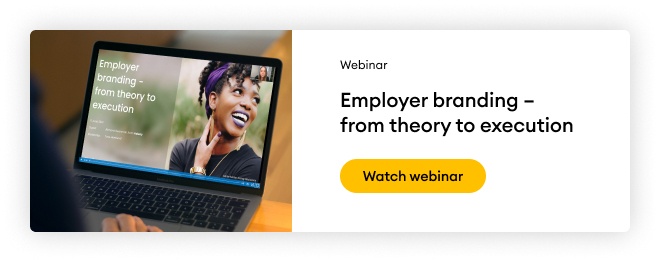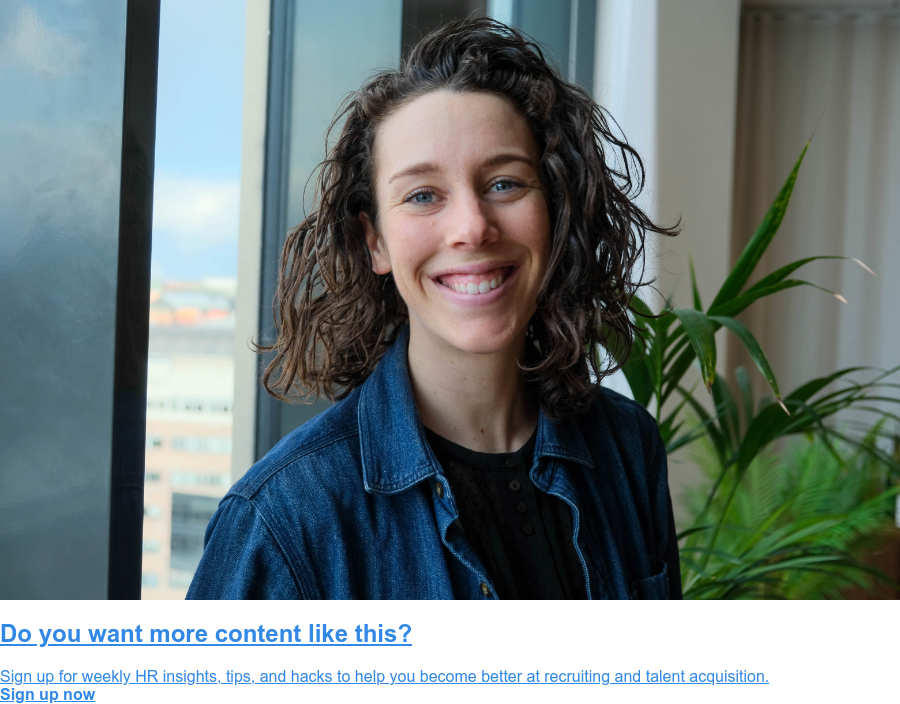What an employer brand is & and isn't
Let’s get one thing straight. Your employer brand is different from your company brand.
While your company brand exists to primarily sell your product or service, the end-goal of your employer brand is to attract high-quality candidates and retain employees, helping you compete effectively in the job market.
A job well done is when a candidate engages with your brand and gets a sense of:
- Your story and founding values
- How you’re different from the crowd
- Your company culture
- The lifestyle and identity that comes with being employed at your company
- How other employees feel about coming to work everyday
Did you know? All organisations have an employer brand. Whether you’ve consciously sought to develop one or not, your brand is based on the way others perceive your organisation. That’s why it’s all the more important to not just talk about your organisational values, but also highlight and amplify the employee experience.
Ultimately, employer branding is about the marketing tactics and strategy you put in to show why your organisation is the ultimate place to work. This starts from the moment a candidate checks out your company, down to when you're conducting interviews, making an offer, and retaining your employees.
Why a strong employer brand matters
Your employer brand trickles down to your core business foundations—from your financial bottomline to how you recruit, retain talent, and perform as an organisation.Companies with a strong employer brand enjoy:
- A 50% reduction in cost per hire compared to companies with poor employer branding
- Double the number of qualified applicants coming in
- A 28% less employee turnover rate
Meanwhile, companies who fail to invest in their brand lose roughly $5,000 per employee.
Key takeaway: It’s the organisations who deliver on the experience they promise that enjoy the biggest slice of the pie: increased application rates, lower recruiting costs, and higher employee engagement. And happy, engaged employees means you are more likely to get referrals, positive reviews, and higher productivity rates. This makes investing in your employer brand a smart business move.
Related reading: Employees can be powerful assets to have in your corner. Learn about how an employee advocacy on social media boosts your organic reach, builds your reputation, and even fuels your recruitment efforts.
Step-by-step guide to building a powerful employer brand
Employer branding should be part of your ongoing efforts to connect with candidates and employees alike. Start by testing your messaging and content, and keep an eye on how people are responding to your brand. Try our simple, step-by-step method to build an effective employer brand.- Run a brand audit
- Create an Employee Value Proposition
- Map candidate funnel
- Tailor communication to funnel stage
- Test, rinse & repeat
#1 Run a brand audit
The best way to start is to go inwards and see how your current employer brand is faring. Conduct an audit to find out how candidates, employees, and former employees engage with your brand. In other words, what’s their experience working with you?
Maybe this could look like crafting a company-wide survey, or adding a simple question to the bottom of your screening process to see how prospective candidates have found out about you. For example, if LinkedIn is the main way prospective applicants hear about you, chances are, you’re doing something right with your LinkedIn communication.
#2 Create an enticing Employee Value Proposition
An Employee Value Proposition (EVP) is your company’s key perks that make up your employer brand. Think of it as a promise—what do employees and job seekers get from working with you? In other words, what company “goods” are you offering?
Make a list of benefits and key perks you offer, and let that shape your EVP. This means that when attracting candidates, you can give prospective applicants a reason to want to work for you.
As Alva's Social Media Manager, Maja Magiera notes:
#3 Map candidate funnel
Considering your brand is the first beck of call for both the candidate’s experience with your hiring process and their journey travelling down your funnel— it’s super important to target candidates at every stage of the journey. This is where your candidate funnel comes in.
While there are many different ways to divide your funnel, generally speaking, candidate funnels are split into the following levels: awareness, consideration, and the action stage.
This kind of matrix enables you to easily visualise where you are leading in the funnel, and where you need to tweak your communication to fit with where the candidate is at with your brand.
For example, before candidates apply for a position at your company, the majority of candidates are in the awareness stage. This means that they will interact and perceive your brand differently than when they’re in the action stage (ready to apply for an open role).
Moreover, working with the candidate funnel enables you to easily identify where you are leaking in your talent engagement strategy, providing you ample opportunity to fix your communication.
#4 Tailor your communication to funnel stage
Usually, you have two types of candidates who come into the funnel. The ones that barely know you exist, and the engaged ones who’ve heard about you at least once.
Are you ready to apply your marketing hat on?
Stage one: Awareness
Since the candidate doesn’t know anything about you just yet, they’re probably not on the job boards just yet. This means you have to go after them! The best way to do this is to produce content rich with your EVP. How can you show them you’re an inspiring and engaging company to work for?
Method: Pinpoint where prospective candidates live (most hang out on at least one social media platform like LinkedIn or Twitter). Next, target the spaces they are in with tailored content.
Content ideas: Add authentic insights into your workplace culture. Perhaps you can share a “day in the life of” type of content, or create a compelling narrative around the employee experience, team building activity, or the likes. Leverage mediums like images or video to create a compelling story. Alternatively, text-rich posts with storytelling (opening with a hook, highlighting a personal pain point, and positive outcome) are highly popular.
Measuring impact: At the awareness stage, you’re not looking to convert job seekers into candidates just yet. Rather, your aim is to spread the word and gain brand visibility. Therefore, solid metrics to focus on include how many new connections you get, follower count, and post views.
Extra tip: Sync with your marketing team and ask for their input. What kind of metrics can you grab and start with?
Stage two: Consideration
In the consideration stage, the candidate knows about you and has some sense of who you are and what your core mission is. Now it’s time to cultivate trust and amplify your visibility.
Method: Double down on your content efforts and really hone in on your company’s identity and who you are. More likely than not, the candidate has either visited your site a couple of times or has submitted a contact form. If they’ve visited your site, a good approach is to set up retargeting ads to entice prospects to check out your company page or careers section.
If a prospective candidate has entered the pipeline, you can also send an internal employee newsletter, and show them further what it’s like to belong within your organisation.
Content ideas: Sharing video or text testimonials of what employees think about working for you is a powerful way to provide social proof. Whatever yo udo, make sure you’re focusing deeper into who you are.
“What’s in it for me type of content usually works. What do other coworkers feel about working with us? You can start pushing out that messaging.”
Measuring impact: Some metrics you can track at the consideration stage include landing page impressions, actual engagement with your content (likes, comments, click-through-rates to your site) and open rates if you’re sending out emails.
Stage three: Action
Congratulations, the hard part is over! Prospects are incredibly close to applying for a role at your company. They have a firm understanding of who you are, what you do, and why you do it. Better yet, they trust you and believe you’re a solid organisation with great values.
As Richard Swenman, Adway's Partnership Development Manager says:
Method: It’s time to close the prospect and get them into the candidate pipeline. This is where you should highlight what the candidate gets from joining your company.
Content ideas: Creating a compelling narrative around the lifestyle benefits of joining your organisation will get you far here. Do you offer generous annual leave and parental leave? Does your company adopt a flexible work policy, or offer a four day work week? Are sabbaticals an option? Talk about the perks of joining, and better yet- leverage your employees to share stories of what their lifestyles are like as a result of working at your company.
Measuring impact: Useful metrics include career site visits, number of listing views and the number of completed applications. Interestingly, if there’s a candidate drop off rate at the application stage, then that’s also a good indicator of what you are doing wrong.
#4. Test, rinse & repeat
The best way to see what’s working and what’s not is to actually do it! Try different content methods, keep an eye on metrics, reiterate and repeat. For instance, if your aim is to get a diversity of applications coming in, then asking yourself the big questions is key: What’s the division among candidates? When do they drop off? Which channels lead to actual employment? What’s the ROI on applications, and which methods provide the best value?
To wrap up
Remember, a powerful employer brand leads to 50% more qualified applicants. Employer branding is critical if you’re looking to attract and retain talent, but obviously, deep work doesn’t happen overnight.
Start taking employer branding seriously, and we promise, you’ll be rewarded with a pipeline full of qualifying applicants!
If you need more guidance, perspective, or insights, sign up to our weekly newsletter!









